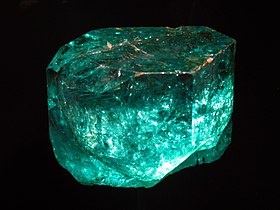
Emerald
Emerald is a gemstone and a variety of the mineral beryl (Be3Al2(SiO3)6) colored green by trace amounts of chromium or sometimes vanadium.[2] Beryl has a hardness of 7.5–8 on the Mohs scale.[2] Most emeralds have much material trapped inside during the gem's formation,[3] so their toughness (resistance to breakage) is classified as generally poor. Emerald is a cyclosilicate.
For other uses, see Emerald (disambiguation).Emerald
Beryl variety
Be3Al2(SiO3)6
Hexagonal (6/m 2/m 2/m) Space group: P6/mсc
(6/m 2/m 2/m) – dihexagonal dipyramidal
a = 9.21 Å, c = 9.19 Å; Z = 2
537.50
Bluish green to green
Massive to well Crystalline
Imperfect on the [0001]
7.5–8
White
Transparent to opaque
Average 2.76
Uniaxial (−)
nω = 1.564–1.595,
nε = 1.568–1.602
δ = 0.0040–0.0070
None (some fracture-filling materials used to improve emerald's clarity do fluoresce, but the stone itself does not)
Etymology[edit]
The word "emerald" is derived (via Old French: esmeraude and Middle English: emeraude), from Vulgar Latin: esmaralda/esmaraldus, a variant of Latin smaragdus, which was via Ancient Greek: σμάραγδος (smáragdos; "green gem") from a Semitic language.[4] According to Webster's Dictionary the term emerald was first used in the 14th century.[5]







